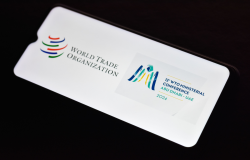How to Move the Global Water Agenda Forward: A Look at Agriculture, Health and Economics
Together with the Heinrich Böll Foundation and the National Wildlife Federation, the Wilson Center's Environmental Change and Security Project co-sponsors a panel discussion on the inextricable linkages between water and food security.
Overview
Water and Agriculture: How to Improve Both Water and Food Security
Together with the Heinrich Böll Foundation and the National Wildlife Federation, the Wilson Center's Environmental Change and Security Project co-sponsored a panel discussion on the inextricable linkages between water and food security. The discussion focused on ways to strike a balance between two somewhat contradictory development goals: 1) enhancing local food security by promoting agricultural production and 2) preserving or increasing access to clean water for drinking and other domestic uses. Liane Schalatek of the Heinrich Böll Foundation moderated the discussion, which included panelists Richard Affleck from the U.S. Department of Agriculture and Shiney Varghese from the Institute for Agriculture and Trade Policy.
Liane Schalatek opened the meeting with remarks on the breadth of the world's food security problem stating, "There are currently more than 800 million hungry or undernourished people in the world, many of whom reside in water scarce regions where rain-fed production is the dominant agricultural technique." Schalatek illustrated the connection between clean water and local food security by noting the water intensive nature of agricultural production. She said that over 75% of all human water consumption is associated with agricultural activities.
As the world's population grows, it will become more and more challenging to feed the people while managing land and water resources in a sustainable manner. Schalatek noted that if the world is to make real progress toward reducing the number of hungry and thirsty people, the international community must encourage the implementation of technologies and management practices that will minimize water consumption and pollution while maximizing harvests. In short, Schalatek said, we must strive to generate "more crop per drop."
Richard Affleck also emphasized the need for higher levels of water efficiency and expressed "little doubt that agriculture will need to cede a portion of its water use to the industrial and domestic sectors." As populations grow and industrial development increases, the agricultural sector will have to provide greater yields using fewer water resources.
Affleck acknowledged that this shift will not come easily and will likely require a combination of technology and policy tools to better manage water supply and demand. More specifically, he called for widespread implementation of techniques such as water harvesting and wastewater recycling to help augment available water supplies. In addition, Affleck strongly supported adherence to Peter Gleick's "soft path" to water management, which focuses on reducing the demand for water. He said that national governments could promote more efficient irrigation techniques and reduce water subsidies in order to give farmers a means and an incentive to conserve.
Along with his call for greater water efficiency, Affleck suggested five additional strategies for increasing food security: 1) investing in agricultural research; 2) developing rural transportation infrastructure; 3) facilitating access to clean water; 4) creating targeted income earning opportunities; and 5) promoting women's education.
Shiney Varghese also spoke in favor of increasing agricultural efficiency through demand management techniques. Varghese expressed a strong belief that subsidies are largely to blame for creating many of the inefficiencies and inequalities in the agricultural sector. She noted that individuals and corporations that control large shares of water resources tend to draw the most benefit from water subsidies and are responsible for most of the waste. Varghese stated, "Elimination of subsidies could go a long way toward improving local food security by helping to strengthen the positions of small local farmers and promoting more sustainable use of water in agricultural practices."
Several participants suggested that technology could also play an important role in enhancing local food security. For example, genetic modification can produce drought and pest resistant crops that require less water and fewer pesticide applications. Some felt that such techniques could help reduce water requirements and promote the sustainable growth of the agricultural sector.
Varghese acknowledged the potential benefits of science, but cautioned against the temptation to look for strictly technological solutions to food and water insecurity. "In most countries," she said, "engineers dominate water resource ministries and rely heavily on technological and structural management methods. People often suggest heavily subsidized solutions for bolstering water supplies such as dams and canals that end up harming the environment and benefiting those who control the resources." Varghese pointed to her native India where she said a proposed inter-basin transfer project threatens the ecological integrity of several major rivers and offers questionable economic benefits. She insisted that truly effective management must combine less invasive technological fixes with institutional change that supports environmentally sustainable local agriculture.
Water & Economics: Opportunities and Risks of Trade & Public-Private Partnerships
Beginning at the World Summit for Sustainable Development in Johannesburg, the private sector is increasingly being seen as an important partner in sustainable development. The Water and Economics panel examined the potential and risks of public-private partnerships in the water sector as well as challenges in developing financing tools and institutions to fund water infrastructure projects in developing countries.
The most controversial (and well-known) model of private sector involvement is multi-national water companies purchasing concessions to own and run formerly public water utilities. Jennifer Bremer emphasized that after a decade, these companies have found it very difficult to turn a profit, and have in some cases pulled out of their concessions. Because of waning interest in investment in the water sector, Bremer suggested that now governments should look at alternative ways to bring private sector capital and expertise to bear on water and sanitation utilities.
Eric Gutierrez of WaterAid highlighted a successful public-private partnership in Uganda where the private sector partner provided management consulting for the water utility. He pointed out that as recently as 1998 Uganda had a very inefficient water utility, but that it now turns a profit due to improved efficiency and management strategies. Gutierrez acknowledged that some have expressed fears that the underlying strategy of reforms is significantly decreasing the role of the state, but overall Gutierrez felt that private sector management has not been contentious in the Uganda case because it is clear to both employees and the public that National Water (the government agency) is clearly in control of overall water policy.
When asked about parameters for private sector involvement, Gutierrez suggested that the private sector should only be brought in if it can perform more efficiently and operate at lower costs than the public sector. Given many of the efficiency reforms were actually undertaken by the public utility itself, audience members questioned whether the private sector was really needed. Gutierrez commented that it was a World Bank requirement that they bring on a private sector partner to provide management consultation for National Water. He emphasized that a major lesson-learned is that there has to be a strong national policy, and active government participation in development of reforms before the private sector is brought in.
On the darker side of privatization issues, Elizabeth Peredo briefly discussed the famous riots sparked by water privatization in Cochabomba, Peru. She argued that multi-national companies do not have local communities needs and challenges in mind when they privatize water systems. She suggested that before countries turn to large infrastructure projects, they should examine indigenous delivery systems and determine if there are ways to modify these systems for higher efficiency.
Panelists and participants also discussed in depth the many challenges in financing the water sector in developing countries. Jennifer Bremer noted that in the beginning, the World Bank and others emphasized full-cost recovery for all water sector projects. She noted that there appears to be a shift away from this, with acknowledgement that some subsidy will be necessary to provide water for the poor. Bremer also reminded participants that often in developing countries poor people who do not have access to the public water supply system pay more for trucked-water than their middle and upper class counterparts pay for piped water. Bremer noted that it isn't a matter of whether to pay for water, but in finding a more equitable solution where costs are better allocated.
Another challenge discussed was implementing a municipal bond scheme (which is used in United States) to finance water projects in developing countries. Jennifer Bremer noted that it will take a huge amount of investment in legal and financial infrastructure to make such a system work in many countries. Another challenge is the short length of bonds in many countries. 5 year lengths are typical in developing countries whereas United States municipalities usually issue 30-35 year bonds to finance water and sanitation projects.
As the concept of public-private partnerships in the water sector matures, panelists noted that we are seeing more creative tri-sector partnerships that include NGO and local community partners. There is also an expansion in the perception of private sector partners. In previous years people always thought of the private sector as large multinational water infrastructure companies. In reality there are many ways to include local private sector partners who may seem more trustworthy to local communities as well as be more accountable to local governments. Local and national economies also benefit through creation of more jobs in local communities and increases in local private sector revenue. Audience members did caution that sometimes local operators cannot service the amount of debt that is needed for investment in large water projects, making foreign investment sometimes necessary.
Water & Health: The Importance of Addressing Population Issues
Water and health are inextricably linked. 5,000 children a day die from diarrheal diseases, and 3 million deaths worldwide are from preventable water-related illnesses. Panelists Christine Durbak, Stan Berstein, and Pavani Kalluri, led the discussion on water and health, moving the agenda forward. Christine Durbak began the discussion with sobering statistics, citing that 2.4 billion people do not have access to sanitation and that 10 percent of the world population do not have access to a clean water source. She emphasized that the failure to address water issues is both a problem of politics and economics. Stan Bernstein led the audience through population and water connections, pointing out that demographic trends such as population growth, urbanization, and migration, along with increases in water consumption trends will profoundly impact the ability of governments to provide clean water and sanitation services to their populations. Bernstein also emphasized that circular migration (rural to urban to rural) will impact water availability in rural areas as people migrating from cities back to rural areas bring changing dietary and household water consumption patterns. Peri-urban areas, Bernstein predicts, will be in the most dire straits.
Bernstein also discussed the lessons-learned from ICPD, 1) We need a transforming view where policymakers and politicians must be able to extend their time horizons; 2) Women are central to progress of attainment of Millennium Development Goals; 3) Local participation and control is important; and 4) Finding a balance between public and market sectors is crucial. He also emphasized that problems will always exist only the nature of the problems change. This means that we must focus on building institutions that can adapt to and address these changes.
Pavani Kalluri of the explained the Center for Disease Control's new point of use water system called the Safe Water System—a home-based system to prevent diarrheal disease. In addition to the CDC, UNICEF, and PSI are also partners. The system includes both a "hardware and software" approach meaning that it combines equipment and technology with public information and education. The system uses a chlorine containing solution to treat water that people collect from outside their home, then keep in small-neck containers to reduce its exposure to pathogens. In addition the system relies on educational materials and community workers who visit families to discuss safe water practices, how to use the system, and basic hygiene education.
Studies to date indicate that the system consistently reduces diarrhea by at least 25%. Its other advantages include ability to be rapidly implemented; can be used in emergency response situations or at home; promotes local entrepreneurship; and is cost-effective worldwide, costing less than 1/10 of a cent per liter of water. Over the last decade user amount has risen to 1 million users. By 2007, the team would like to see that number up to 100 million users.
Lessons learned from the Safe Water System experience demonstrate that institutions and policies need to fit national and local needs. While national government policy and political will is important, Safe Water Systems teams found that in some places the impetus for developing safe water systems comes from outside the country, such as in Afghanistan.
To build awareness of the project the Safe Water System team has recruited many partners from different sectors. Local NGO and private sector partners have been especially important. The market-based distribution strategy naturally builds networks of local distributors and producers, and community health workers have been instrumental in introducing these products into communities and encouraging use.
Kalluri also acknowledged that this is not a substitute for infrastructure and does not solve all problems. Women and girls still must spend time collecting water-- taking away time from education and income generating activities. Point of use systems in general do not address the problem of why the water supply is bad in the first place. Others asked whether supplies of the chlorinating product were dependable once people relied on the system for safe drinking water. Kalluri acknowledged that dependable supply is a concern in any point-of-use system and said that they had supply problems in Madagascar when production fell short. Currently they are trying to determine the cost effectiveness ratio of point of use vs. infrastructure systems.
Participants agreed that safe drinking water is universally understood, but acknowledged the lack of political will to get move forward. Participants discussed various levels at which action needs to be taken and laid out strategies for the local, national, and international level. Participants suggested that the donor community and national governments should think about local vs. national strategies and how these two can be integrated. One suggestion for leadership on the national level was that all countries must adopt an integrated national water management plan and recognize water and health as important strategies in their national poverty reduction strategies. It was noted that accountability and monitoring should be important parts of these strategies and that a process needs to be created where policy objectives can be aligned with indicators that policymakers and technicians can look to. On the local level, participants emphasized that culturally appropriate educational materials and community outreach workers are absolutely integral to teaching about the relationship between water and health issues, building demand for sanitation, and getting people to use point-of-use products. It was also noted that local and national governments could integrate water, family planning, and health interventions to address a full range of needs within communities. At the international level participants agreed that the UN should focus on implementation rather than continue discussing the problem. Kofi Annan will announce the UN water plan in January 2004 giving advocates time for input into that process. The session ended with a discussion around the disconnect between the recognition that integrated water and health projects were needed and the amount of funding available for these projects. The group acknowledged that a continuing challenge will be how to get donor communities to fund integrated projects.
Drafted by Jennifer Kaczor and Kurt Rakouskas.
Speakers
Richard Affleck
Liane Schalatek
Shiney Varghese
Jennifer Bremer
Eric Gutierrez
David Hales
Elizabeth Peredo
Stan Bernstein
Christine Durbak
Pavani Kalluri
Karin Krchnak
The Nature Conservancy
Hosted By

Environmental Change and Security Program
The Environmental Change and Security Program (ECSP) explores the connections between environmental change, health, and population dynamics and their links to conflict, human insecurity, and foreign policy. Read more
Thank you for your interest in this event. Please send any feedback or questions to our Events staff.










